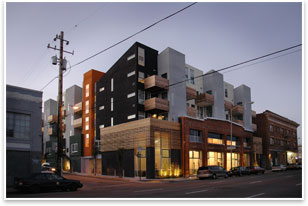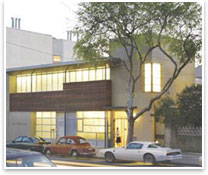Are You Going to (See) San Francisco?
Convention tours take visitors through many scales of San Francisco’s urban fabric—sidewalks to sustainable building
by Layla Bellows
Summary: The best lessons architects can take home from the 2009 AIA National Convention in San Francisco could very well be the ones they get on tours of the city’s neighborhoods and its homegrown design solutions. With Renzo Piano’s Academy of Sciences, Daniel Libeskind’s Contemporary Jewish Museum and Thom Mayne’s Federal Building dotting its streets and parks, it’s no secret San Francisco has become a hotbed of contemporary architecture.
But equally stellar design solutions to issues affecting cities throughout America also exist — if a bit more quietly — throughout downtown San Francisco and the neighborhoods surrounding it. Some tackle low-income housing, others tackle neighborhood preservation, and still another alleviates the pollution from storm water runoff on residential streets.
Although these projects might not receive the kind of attention San Francisco’s signature buildings virtually demand, the local organizers of the AIA 2009 National Convention’s educational tours believe they hold an equally important place in the practice and have developed a number of educational tours surrounding homegrown design innovations.
“There is a whole lot of really important work that is changing the form that happens on a much smaller scale,” Margie O’Driscoll, executive director of AIA San Francisco, says of the local initiatives. “And that work is informed by a passion for two things: sustainability and reducing our carbon footprint, and the second is social responsibility.”
Sustainability
One of the more revolutionary sustainable design movements in the Bay Area takes place right on San Francisco’s residential streets—or sidewalks, to be exact. Plant San Francisco is an organization dedicated to converting excess sidewalk pavement into permeable landscape. In other words, those places where people don’t walk anyway get turned into xeriscaped, curbside gardens.
“Like a lot of cities, we have a real problem with too much storm water being diverted into the bay,” O’Driscoll says. “By creating permeable landscape, the water is absorbed into the ground as opposed to running off the sidewalk into the sewer system and out into the bay.” The permeable solutions developed by Plant San Francisco’s founding director, Jane Martin, will be explored in “Plant San Francisco—Permeable Sidewalk Landscaping.”
Unlike many American cities, San Francisco has a great public transit system, and convention organizers, sticking true to their sustainability goals, were mindful of this as they put the tours together.
“The vast majority of our tours are using public transportation,” tour co-chair Bryant Rice says. “That was important and that did factor into some of our tours. Many of our tours are a celebration of our transportation.” One example is “Art and Architecture in the Transit Realm,” which highlights the collaboration between transit system architects and the artists whose work adorns the stations.
Social responsibility
When the economy takes a dive, the inevitable fallout is an increase in homelessness, which increases strain on cities, most of which already have a difficult time serving citizens most in need of their help.
“When we look at the economic demise that’s happening in this country and what kind of social network there is to help people get jobs and live healthfully and happily,” Rice says, “there aren’t very many good models, and we feel like we have some.”
 One such example is Plaza Apartments, a team-design project by Leddy Maytum Stacy Architects and Paulette Taggart Architects. It’s a LEED silver-certified complex providing permanent housing to the chronically homeless. Although it is equipped with space for social workers and on-site health-care staff, the building has a decidedly non-institutional feel thanks to its earth tones and retail and black-box theater space on the ground level. The tour “Juxtapose: Sustainable Practice and Affordable Housing” will compare this structure to David Baker + Partners Architects’ Folsom/Dore Apartments, another LEED silver certified, affordable residence, only this one has been designed specifically to serve people with physical and developmental disabilities, and people struggling with HIV/AIDS. One such example is Plaza Apartments, a team-design project by Leddy Maytum Stacy Architects and Paulette Taggart Architects. It’s a LEED silver-certified complex providing permanent housing to the chronically homeless. Although it is equipped with space for social workers and on-site health-care staff, the building has a decidedly non-institutional feel thanks to its earth tones and retail and black-box theater space on the ground level. The tour “Juxtapose: Sustainable Practice and Affordable Housing” will compare this structure to David Baker + Partners Architects’ Folsom/Dore Apartments, another LEED silver certified, affordable residence, only this one has been designed specifically to serve people with physical and developmental disabilities, and people struggling with HIV/AIDS.
Social responsibility doesn’t just come in the form of creating new space for underserved communities; sometimes it can be as simple as preserving a neighborhood’s traditions. Such is the case in San Francisco’s Mission district.
“The Mission is a traditionally Hispanic neighborhood in the city,” Rice says, “It’s going through gentrification; a lot of those families are selling their houses and moving out of the city.”
 It leaves residents with the question of how to maintain the culture of a neighborhood while the population changes. Within the Mission district, two enduring facets are its vibrant and often politically minded murals and La Cocina, an organization dedicated to helping women launch small food businesses. Both will be explored in the tour “La Mission Caliente! Culture in a Gentrified Neighborhood.” It leaves residents with the question of how to maintain the culture of a neighborhood while the population changes. Within the Mission district, two enduring facets are its vibrant and often politically minded murals and La Cocina, an organization dedicated to helping women launch small food businesses. Both will be explored in the tour “La Mission Caliente! Culture in a Gentrified Neighborhood.”
The takeaway
Each of the AIA San Francisco’s educational tours offer a unique glimpse into practices that are shaping how architects can think about design and their role within their communities. And this is made possible in no small part by the project architects leading the tours.
Developing new strategies and approaches toward solving architectural and design dilemmas is never easy. Even something as simple-sounding as replacing rarely used portions of sidewalks with permeable planters required extensive discussions with city officials to address concerns about public safety—pebbles within the permeable landscape can present tripping hazards—and maintenance—there is a vast difference between the responsibility of sweeping a sidewalk and maintaining a planter. Martin isn’t just serving as this tour’s leader, she is also a purveyor of important information about the pitfalls and triumphs she encountered along the way, just as all of the educational tour guides are.
Although the project leaders will explain how they made it possible to innovate within their own city, their purpose is exactly opposite of providing the ideal approach. The viewpoint, Rice explains is “This is a solution; this is not the solution.
“They may love some of this stuff; they may see it as not being applicable to their own situations,” he says, “but they will learn from it.”
O’Driscoll shares this belief. “When we do tours, it’s about what the design process revealed,” she says. “When you engage in a dialogue about the context of San Francisco—how we get work done, it has lessons for anybody from another city.”
|



